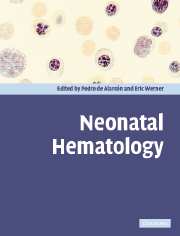Book contents
- Frontmatter
- Contents
- List of contributors
- Foreword
- Preface
- 1 Neonatal hematology: a historical overview
- 2 Disorders of the fetomaternal unit
- 3 Erythropoiesis, red cells, and the approach to anemia
- 4 Anemia of prematurity and indications for erythropoietin therapy
- 5 Hypoplastic anemia
- 6 Hemolytic disease of the fetus and newborn
- 7 Neonatal hemolysis
- 8 Neonatal screening for hemoglobinopathies
- 9 Polycythemia and hyperviscosity in the newborn
- 10 Newborn platelet disorders
- 11 Neutrophil function and disorders of neutrophils in the newborn
- 12 Immunodeficiency diseases of the neonate
- 13 Hemostatic abnormalities
- 14 Transfusion practices
- 15 Umbilical-cord stem-cell transplantation
- 16 Neonatal oncology
- 17 Normal values and laboratory methods
- Index
- References
1 - Neonatal hematology: a historical overview
Published online by Cambridge University Press: 10 August 2009
- Frontmatter
- Contents
- List of contributors
- Foreword
- Preface
- 1 Neonatal hematology: a historical overview
- 2 Disorders of the fetomaternal unit
- 3 Erythropoiesis, red cells, and the approach to anemia
- 4 Anemia of prematurity and indications for erythropoietin therapy
- 5 Hypoplastic anemia
- 6 Hemolytic disease of the fetus and newborn
- 7 Neonatal hemolysis
- 8 Neonatal screening for hemoglobinopathies
- 9 Polycythemia and hyperviscosity in the newborn
- 10 Newborn platelet disorders
- 11 Neutrophil function and disorders of neutrophils in the newborn
- 12 Immunodeficiency diseases of the neonate
- 13 Hemostatic abnormalities
- 14 Transfusion practices
- 15 Umbilical-cord stem-cell transplantation
- 16 Neonatal oncology
- 17 Normal values and laboratory methods
- Index
- References
Summary
Ancient concepts of the blood were described by Hippocrates and Galen 2000 years ago in their doctrine of “humors.” It was believed that the body was made up of four humors – blood, phlegm, black bile, and yellow bile – and that these four components had the qualities of heat (“hot-blooded!”), cold, moist, and dry. The Galenic concept of the blood prevailed through the Middle Ages. Health or disease was a result of a balance or imbalance, respectively, between these humors, and this was the basis of the practice of therapeutic blood-letting (which, fortunately, was performed infrequently in children) through the mid nineteenth century as a way to rid the body of the abnormal humors believed to cause a wide variety of diseases.
The hematology of the fetus and newborn is a relatively recent area of study whose development depended upon the evolution of the science of hematology and, especially, upon methods to study the blood and its elements. As Wintrobe has pointed out, the development of the field of hematology has been driven by technology. He divided the evolution of hematology into two general areas: morphology, which relied on the development of microscopy, and quantitation of the elements of the blood, which came later [1].
The invention of the microscope enabled identification of the blood cells. Antonj van Leeuwenhoek, working in Delft, Holland, constructed a primitive microscope from a minute biconcave lens mounted between two metal plates attached to a screw that permitted focussing.
- Type
- Chapter
- Information
- Neonatal Hematology , pp. 1 - 9Publisher: Cambridge University PressPrint publication year: 2005



